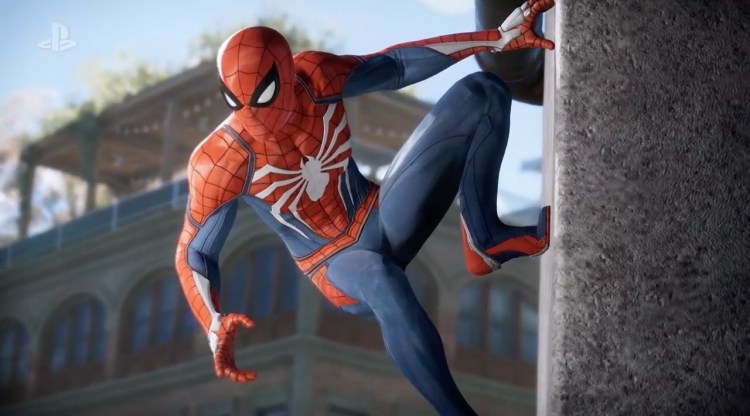Ted Price is basking in the glow of the success of Marvel’s Spider-Man, which has sold more than 9 million copies since it debuted last fall. But the CEO of Insomniac Games had very humble beginnings in the video game industry.
He started Insomniac Games (first known as Extreme Software) in 1994. With Al Hastings and his brother, Brian, Price went to work on Disruptor, a science fiction shooter game that publishers repeatedly rejected. Price was down to his last $1,000. They started developing Disruptor for the 3DO, but that early game console started tanking. So Mark Cerny, a producer at Universal/Cerny Games, suggested they switch the game to the PlayStation, Sony’s fledgling game console.
Universal published Disruptor. It didn’t do well, but it led to more projects. The next game was Spyro the Dragon, which was a family-friendly platformer with a larger audience target audience than Disruptor. Spyro became a hit, and it’s still around today. Since then, Insomniac went on to bigger games, and now it has crossed its 25th anniversary as a company. Its games include Ratchet & Clank, Resistance, Fuse, Sunset Overdrive, The Unspoken, Song of the Deep, and most recently, Marvel’s Spider-Man.
Insomniac now has 260 employees — Insomniacs — in Burbank, California and other locations. I talked to Price about the company’s history and how it has been able to survive for 25 years in the highly competitive video game business. Price said he is “still learning” when it comes to making games. Our conversation covered the risks of doing virtual reality as well as Price’s own view of leadership, as exemplified when he created a video objecting to President Donald Trump’s Muslim travel ban in January 2017. Price is also a staunch supporter of the Academy of Interactive Arts & Sciences and its annual DICE Summit, where I’ve seen him every year for a couple of decades.
Price will be a speaker at our upcoming GamesBeat Summit 2019 conference on April 23 and April 24 in Los Angeles. Here’s an edited preview of our interview.

Above: Ted Price is CEO and founder of Insomniac Games.
GamesBeat: Congratulations on 25 years. I watched your video, which was nice. Did you guys ever describe much about what happened when you got started?
Ted Price: It’s been rare that I tell the story about it, but I’m happy to share some of the early days. February of 1994, tomorrow actually, 25 years ago, is when we received the approved articles of incorporation from the California Secretary of State. That marks the official beginning of Insomniac. Back then I had filed the articles under Extreme Software. We ultimately changed the name, but in February it was me in a 10’ by 10’ office with a 3DO dev station that I’d spent a lot of my savings on. I had grand hopes and dreams, but very little clue about what it took to make games.
I struggled for a while, and I got very lucky in meeting a guy named Al Hastings, who was in his senior year at Princeton, which was also my alma mater. We’d never run into each other because we were a few years apart, but I called him thanks to an introduction from a friend, and he agreed to come out and join this nascent company as soon as he graduated. What was fantastic about that May-June period when he came out in 1994 was, we dove in and made a demo for a game, our first game, Disruptor.
What Al did was magic. He created a first-person shooter engine in a month. He really is one of the industry’s wizards. He’s an unsung wizard in this industry. We recorded the demo on a VHS tape and we got into my Saturn, which was all I could afford at the time, and we drove up and down California cold-calling every publisher we could. We showed everybody we could the tape and got rejected every single time.
It was about a month later that we were down to my last thousand dollars, which had to pay for the rent on my apartment, the rent on our office, our food, everything. I was thinking that this was going to fail before it even started. But again, another friend called and said, “You should talk to the people at Universal. They’ve just started an interactive division.” We jumped in the car one more time, drove up from San Diego to Los Angeles, and presented the tape to Mark Cerny, who had been brought on as the executive producer at this new publisher.
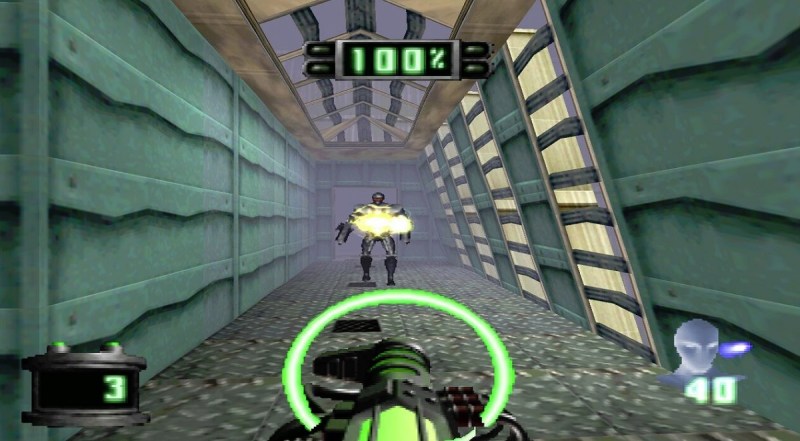
Above: Disruptor was Insomniac’s first game. It debuted in 1996.
He took a look at the tape and he said, “You guys are pretty talented for amateurs. We need to think about it.” We got back in the car and drove down to San Diego, and I thought it was all over. When we got back, my answering machine light was blinking. It was Mark, and he left a message saying, “Let’s do a deal.” That’s where we realized that this could be a thing.
The next thing we did was call Al Hastings’ brother Brian, who was working at Siemens, the hardware company. He agreed to join us, and the three of us began to put together Disruptor in earnest. From there we learned a lot. We’ve been on a great ride since 1994.
GamesBeat: How much did Disruptor sell? What platforms was it on?
Price: We released Disruptor on the PlayStation. We’d intended to release it on the 3DO, but what ended up happening, about midway through production on Disruptor, 3DO as a company tanked. Mark Cerny and a couple of others at Universal suggested that we consider moving over to the PlayStation, because the PlayStation had arrived, and it was a hit at the time. I was panicked. I thought there was no way we’d be able to move everything over. Al very calmly answered and said, “Sure, no problem.” In about two weeks he ported the engine from 3DO to PlayStation.
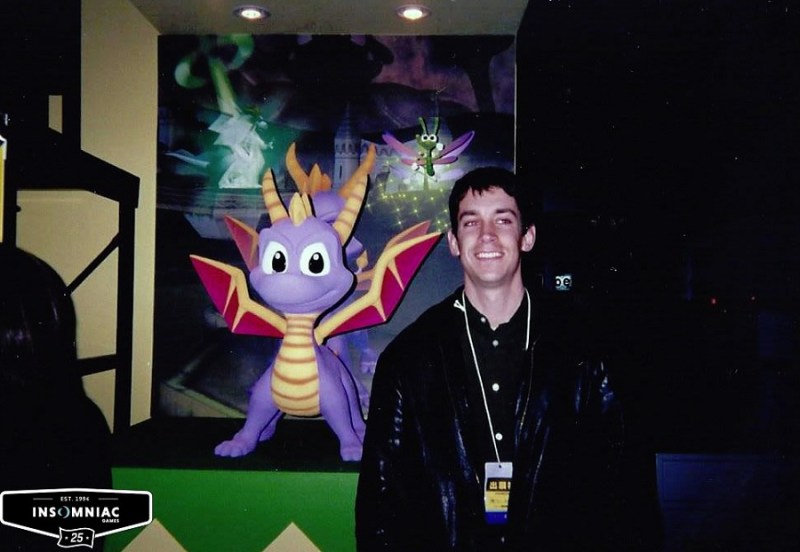
Above: Ted Price in the Spyro days in the 1990s.
GamesBeat: How much capital do you think you put out when you were starting? $10,000, something like that?
Price: It was definitely more than that. I’d been working in a startup medical company. I really didn’t have any expenses, so I saved everything. I did some database consulting and saved all that money again. I lived in a tiny apartment. I didn’t have a fancy car. I played volleyball on the beach for fun, which cost nothing. But my goal, really, was to start a console video game company and create the kind of story-driven games I grew up playing and loved so much.
It definitely required investing in hardware. It wasn’t just a 3DO dev station. I had to buy PCs. Eventually, once we signed the deal with Universal, we picked up a couple of Silicon Graphics workstations, which back then were the pinnacle of computer graphics. I’d always wanted to have a Silicon Graphics workstation and use Alias Wavefront on it. That was one of the benefits of signing a deal with Universal. Of course, since then things have changed.
GamesBeat: How was the reception for Disruptor?
Price: Disruptor was called the best game that nobody’s ever heard of. That was a quote from one of the reviews that came out describing the game. It was well-received, and I think first-person shooter fans who played it — at least the feedback we got was that they really liked the controls. They enjoyed the setups. They enjoyed the world-building, because we had a vision for a futuristic romp through our own solar system visiting various moons around different planets.
The story itself was a lot of fun for us, because we were trying to tell a very serious story, but we unwittingly made it humorous, given many of the scenes where the characters are interacting in a really cheesy way. It became, at least from what we heard, a cult classic, given the goofiness of our characters trying to be very serious.
As an aside, those scenes were filmed on videotape. We didn’t use CG back then. We were taking cues from games like Warhawk and Wing Commander that were using live action. We didn’t have the budgets that these other games had, so if you go back and look the footage, our sets are ridiculously cheap, and the costumes are, ah — they are not too aggressively styled. [Laughs] But I give a lot of credit to the actors and the crew that was helping us try to tell the story.
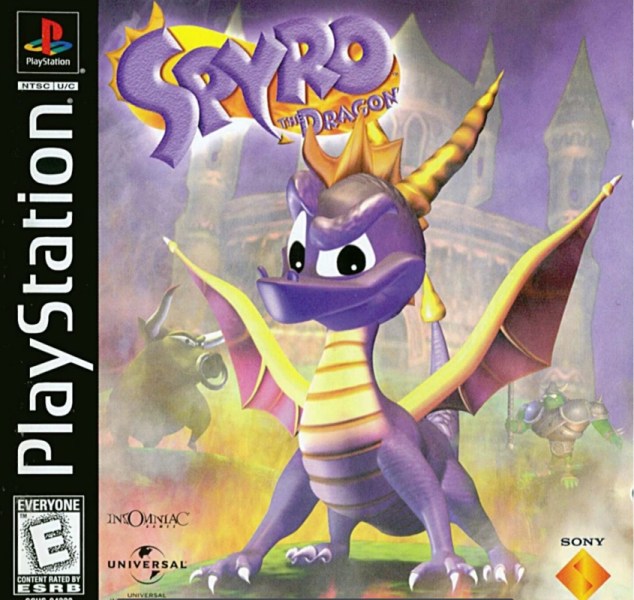
Above: Spyro the Dragon came out in 1998 and was one of a number of collaborations between Insomniac and Mark Cerny.
GamesBeat: You sound like you think of it a little sheepishly now.
Price: I like to go back at the videos on YouTube and laugh at how we came across. But we really loved making the game. Al, Brian, and I, and others who eventually joined, we were FPS fans. It was a great experience for us to learn how to design controls and setups in a way that was consistently fresh for players.
I think also we learned a lot about balancing during that first game, given that it’s not just about your weapons. It’s also about your psionics, these mental powers you have. You’re not moving back and forth between using weapons and your psionics. That helped prepare us the future when we would jump into more complex game loops.
GamesBeat: Was it successful enough to keep you going into making the next game?
Price: It was definitely not a hit. We had a three-game deal with Universal, so what we knew was that the game would likely sell enough to break even, but it wasn’t going to make anybody money. What we needed to do was think laterally and understand what players wanted on the PlayStation and what opportunities there were in the market.
I give a lot of credit to Mark Cerny, who came to us and said, “The PlayStation doesn’t have a lot of family-friendly games. You might want to think about something that would reach a broader audience.” At the time, having finished Disruptor, that was a great suggestion. Disruptor, despite its cheesiness at time, was a fairly dark game. We wanted to create something more lighthearted, more family-friendly.
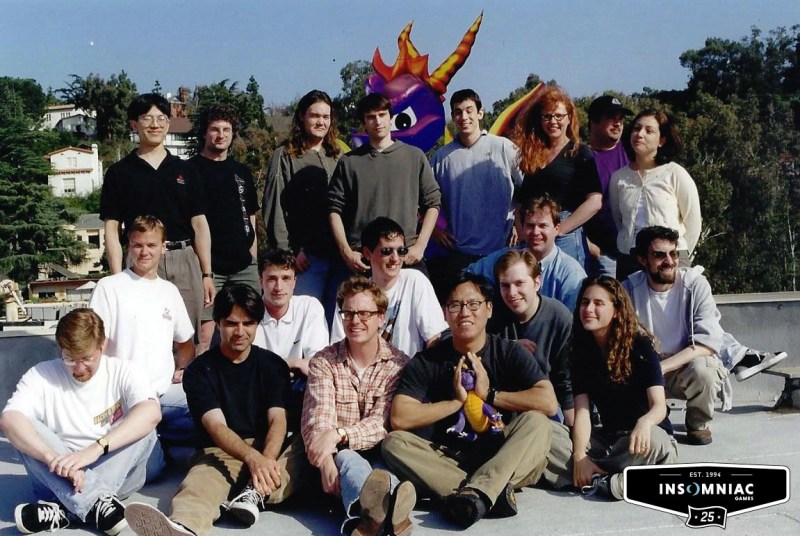
Above: The early Insomniac Games team.
We began discussing ideas, and pretty quickly the idea about making a game centered on a dragon came up. We drove in, and Spyro quickly evolved into a young, adventurous, brash dragon in a world where there were many opportunities to tell a fantastic story with lots of humor. As we starting digging in that started appealing more and more to all of us, and that’s when Spyro was born. And Spyro was a hit.
GamesBeat: How did that intellectual property wind up at Activision? Did it change hands somehow?
Price: No. Universal owned the IP, ultimately, for Spyro. Universal Interactive changed hands several times, eventually becoming part of Activision Blizzard. It went through a lot of mergers. There’s a lot of data out there, a lot of stories about the transition to Vivendi and so on. You can watch as Spyro evolved.
I give them a lot of credit, because for years after we’d moved on from Spyro and began developing Ratchet and other games, Spyro languished. There really hadn’t been any Spyro games that struck a chord with players. But the Toys for Bob guys, with their toys to life idea, really nailed it. Spyro ended up being the perfect vehicle for that.
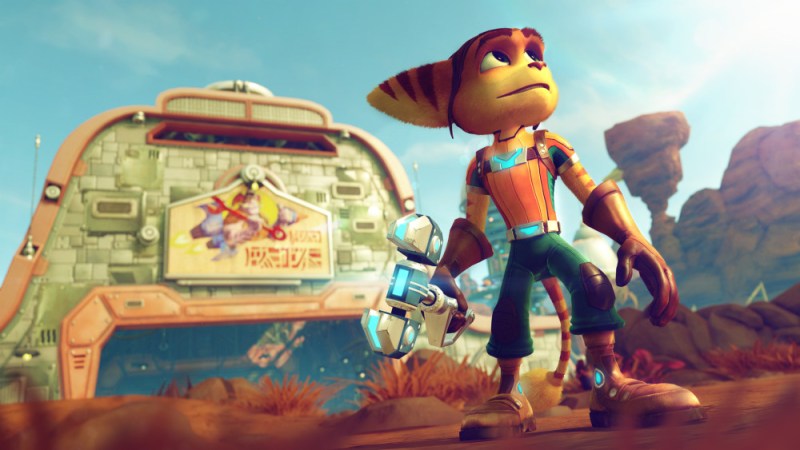
Above: Ratchet once again wonders if he left the gas on.
GamesBeat: The ride across those 25 years, what have been some of your observations about that? Either lessons for other developers, or some moments where maybe you thought you guys weren’t going to make it.
Price: What’s helped us weather the ups and downs of the industry is a commitment to collaboration across the entire studio. Transparency, where everybody knows what’s going on. The commitment to the philosophy that great ideas come from everywhere–as a studio, from the very beginning, we have always relied on an approach where we want everybody to take ownership of the creative process and contribute to it and solve problems as a group.
This is not a company where you have one lead designer or one creative director telling everyone what to do. We never operated that way, and I don’t believe that it works well for a culture like ours, where so many different disciplines are working together to create magic. I feel like we’ve been very consistent, culture-wise, in an industry that tends to be inconsistent.
GamesBeat: It’s a rare thing, to have a company reach 25 years in this industry. Especially a studio.
Price: I’ll also say that we’ve enjoyed working with many different partners as well, and I think we’ve learned a lot from all of our partners who have joined us on this ride. I think that’s been a good lesson for all of us, and probably for others in the industry as well. When you have a great partnership, it amplifies what you can do.
With that in mind, we’ve also self-published titles, but I think some of our best are when we’ve gotten objective feedback from outside of Insomniac. That’s useful. In development it’s easy to get focused on what you’re doing day to day and not be able to take a step back and ask, is this good? Is this going to work? Is this consistent with our original vision? Sometimes having an objective outside party — it could be a publisher, it could be usability testers, it could be anybody — giving you that feedback is key. Another key is to listen to that feedback and evaluate it objectively, not emotionally. We’ve had to learn how to do that.

Above: Resistance
GamesBeat: How many people are you at now?
Price: Right now we have around 260 across our locations.
GamesBeat: Is that a peak for you? Have you gone up and down over the years?
Price: We’ve been relatively consistent. We’ll build up a bit in production. It just depends on the projects we’re doing. I think what’s important here is that we have an amazing retention at Insomniac. Our leadership team, the average has been here more than 14 years. One third of Insomniac has been here more than 10 years. Across all of Insomniac our average tenure is more than six years. I think that puts us in the 99th percentile of the industry.
That has a lot to do with, again, our culture and our interest in having everyone participate in not just the creative process, but also our production process. We ask everyone, “What do you think about how things are going? How can we improve?” We’re not afraid to make changes to our structure and our process to try to decrease barriers to creativity for everybody working on the games.
GamesBeat: You’re at an interesting scale. How do you fathom something like Rockstar, though, with 3,000 people contributing to Red Dead Redemption 2?
Price: That’s a lot of folks. I think every developer has the challenge of balancing scope and expectations. There are a lot of ways that you can approach it. We like to rely on a lot of planning. We try to contain our scope for our games to the things we think players are most passionate about. We make some calls on what is most important and what isn’t. We’ve learned the hard way that if you try to deliver the kitchen sink, it’s a daunting challenge. Some companies can do that. We like to focus on our story-driven open world games and really understand what gets players exciting and double down on those things.
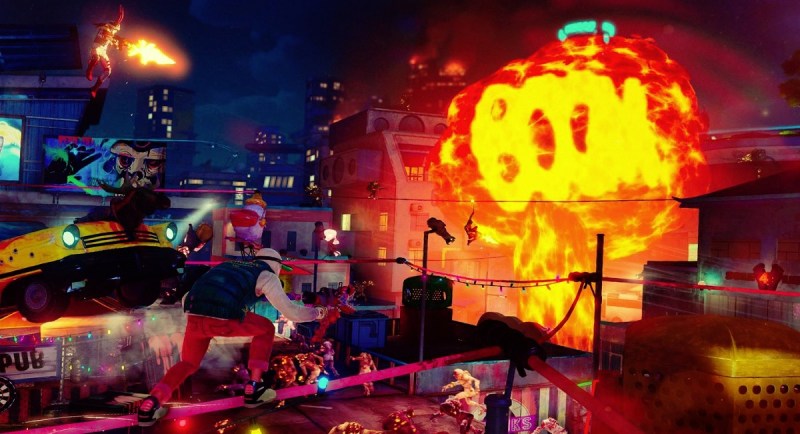
Above: Sunset Overdrive debuted on the Xbox One in 2014.
We also, as technology advances–we’ve made an investment in proceduralism as well. There are production techniques we use where we leverage the tools that we create that are procedural, or outside tools like Houdini or the Allegorithmic Substance library. That saves us time and creates more time for innovation within the games themselves.
GamesBeat: After Spider-Man’s success, how have you looked back on that? It’s interesting that there was this discussion about whether single-player games are dead while you guys were making that. It’s an open world, a very different kind of single-player, but there’s that big discussion at EA about that. Things like Anthem are coming out. What did you think about all those things that were in the mix as you were making Spider-Man?
Price: Can you ask that again?
GamesBeat: I assume you don’t think single-player games are dead.
Price: No, we don’t. I’ll give Sony a lot of credit for being willing to continue driving forward with story-driven single-player games. If you look at God of War, for example, it’s a fantastic example of a well-done single-player game. Fans responded. Obviously Spider-Man is another example, and there are several other examples from Sony first-party.
We’ve done multiplayer games. We’ve done cooperative games in the past. I think there’s absolutely a place for those, a place for those mechanics in many franchises. It just depends on what you as a team feel fits the game the best.
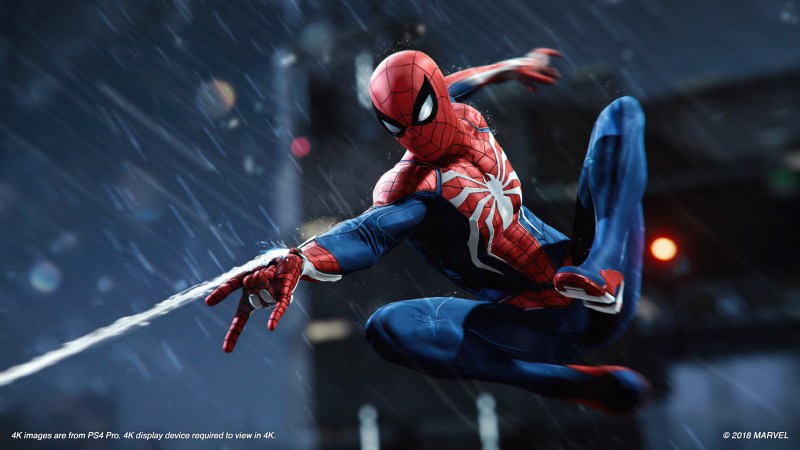
Above: Spider-Man can probably afford rent now.
GamesBeat: Where do you feel you are as a game creator now?
Price: Personally? Still learning. Every single day, no question about it. What’s fantastic about this industry, and one of the reasons we as a company have been around so long, and so many Insomniacs have stayed for so long–this industry is constantly evolving. There’s never a dull moment where you don’t feel like there’s a new hill to climb or something new to discover.
I think a lot of that’s driven by players, who have an insatiable desire to be surprised with new takes on gameplay, new takes on story. Given that we are players as well, we feel that energy doubly, because we love creating and exploring and discovering, but at the same time we want to play games that are surprising us. It’s a great place to be, not only in this time but in this industry. We have amazing tools. We have amazing opportunities. We have fans who are incredibly enthusiastic and want to see more. It’s up to us to create and to do something that isn’t an opportunity in many other industries. It’s pretty incredible for us.
GamesBeat: What kind of games do you still want to make?
Price: Open world story-driven games have obviously been something we’ve focused on, but for us at Insomniac, games that have a positive message are generally the kinds of games that we gravitate to. When I talk about a positive message, usually that involves having stories–characters that are encountering some sort of difficulty and have to overcome adversity as an underdog when they think maybe it’s not possible.
We like telling those kinds of stories because it reflects who we think we are. You mentioned the difference in size between Rockstar and Insomniac. The scale is pretty large. We’ve had to be scrappy from the very beginning and get creative and collaborate very closely to take on much larger teams and deliver the kinds of stories and worlds that fans love. Naturally we gravitate toward telling those kinds of stories.
GamesBeat: What’s your reaction when people say that Spider-Man is the best game you have ever made?
Price: We’re flattered. I can speak for all of Insomniac. It’s humbling and flattering to hear those kinds of compliments. We really appreciate it.
GamesBeat: You wouldn’t quibble with that?
Price: [Laughs] We’re proud of all the games we’ve made. I’ll say as well that–we’ve been blessed to be able to create so many different types of games. Different characters, worlds, mechanics. Every game we have made has been a learning experience for us, an opportunity to build new muscles, even if the game is within the same genre as something before.
I know that here occasionally I’ll get asked, what’s your favorite Insomniac game? The answer is usually all of them, because all of them have had incredibly joyful moments during production, or during preproduction, or after release. I can look back and think, “Those were amazing moments.” The time when we were all gathered around someone’s desks looking at a new mechanic, or looking at one of the cinematics in the game, or we were all collaborating on solving a problem. Those, to me, are the kinds of moments that make this industry so special.
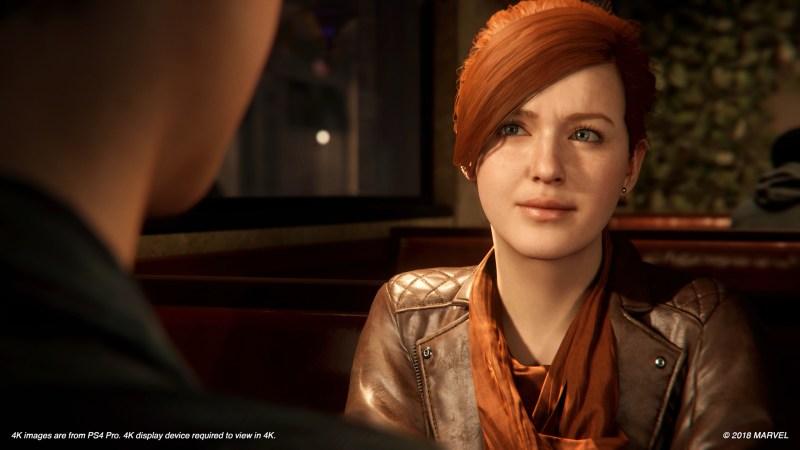
Above: Mary Jane and other Spidey friends are here.
GamesBeat: What did you think of your foray into VR? Where do you think that’s going in the future?
Price: We’re still in VR. We’re in production on Stormland. It’s an exciting game for us, because it’s one of the first open world VR games. We’ll be showing more of it soon to help players understand how far it’s come since the last time we showed it off.
With VR, one of the reasons we got into it was to build new muscles. I mentioned that before. It’s another opportunity for us to learn a different approach to design. We learned quite a lot. A lot of the assumptions we made about game design in VR were wrong at first. We had to figure things out pretty quickly. Given that this is our fourth VR game, we’ve taken those lessons from previous games, applied them, and now we’re pushing further. We’re doing more with locomotion, combat, and interface than we thought was possible when we started in VR. It’s pretty cool for us to see how we internally approach development evolving.
As far as the audience goes, clearly the audience is still evolving as well. We see the hardware manufacturers, Oculus in particular, responding to that. I’ve tried out the Quest and it’s a really cool piece of hardware, very impressive. For me, it changes how I think about VR.
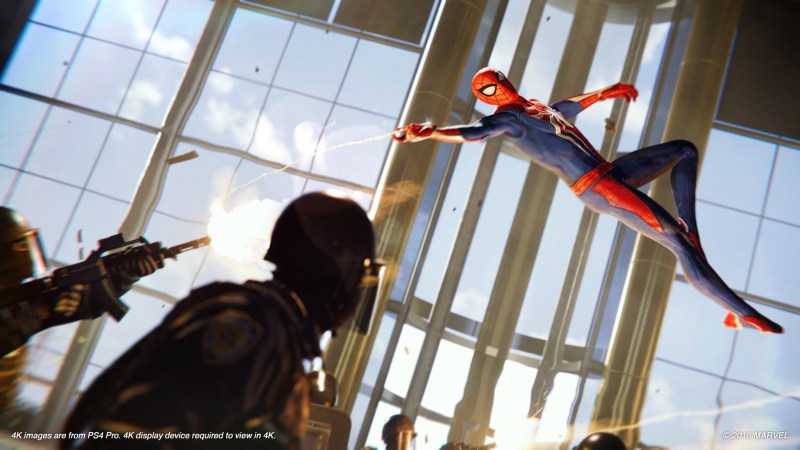
Above: Spider-Man’s combat is customizable with different abilities and gadgets.
GamesBeat: Do you think there was ever anything, aside from those first moments, that ever came close to killing Insomniac?
Price: We’ve definitely had low moments at Insomniac, where we’ve decided not to move ahead with a particular projects. Most developers probably have that. Most of the time people don’t hear about those, but internally we’ve cancelled a number of different games.
One that I’ve been public about was the precursor to Ratchet and Clank. We’d spent a lot of time on a more mature game where I personally was excited about it, but the rest of the team was shaking their heads going, “You’re crazy. This isn’t going to work.” Our partner, Sony, was also saying, “We’re not sure about this, guys.” We made the call to pull the plug on it. It was tough to do that because we’d put a lot of work and time and money into it. But it was ultimately the right decision.
We run into those moments at Insomniac–I wouldn’t say frequently, but enough that it keeps us humble. It helps us understand that we don’t have all the answers. Sometimes the ideas we come up with don’t work. We need to be comfortable with moving in different directions. Often it’s easy to hold on with both hands when everyone is telling you this may not be the best approach. For example, you see usability results that say people don’t like what you’re showing. You have to be comfortable with changing directions. As a company, from the very beginning, we’ve been comfortable with change and moving in different directions. That’s just–this industry demands it.
GamesBeat: It sounds like you haven’t quite cancelled as many games as, say, Blizzard has.
Price: Different companies take different approaches. Some companies begin promoting their games super early, which increases risk. We like to feel confident that the game we’re going to release will have a relatively positive response when we unveil it. But again, you never know. We’re always prepared to be flexible.
GamesBeat: Going forward, how do you think about platforms? Tim Sweeney has talked about things like the need for open platforms for game developers.
Price: Those conversations have been going on for a long time. I don’t think it’s anything new when it comes to open source, open development. What gets most of the Insomniacs excited is sharing. We love to share our tech and our approaches. We like to talk to other teams about culture and what we think works. We like to learn from other teams when it comes to best practices and what other teams think works.
This is an industry where there are lots of conversations going on all the time about culture, about how to create an environment where you can be at your best creatively. Nobody has the right answers. Part of that is because the answers keep changing, given how the industry and the demands on the industry change. But if the conversations continue and everybody can speak honestly with each other and be collaborative in terms of coming up with solutions that work, I think that’s one of the things that makes our industry different.
Going back to sharing, I feel like most of us in the development feel like we’re all in the same boat. There’s nothing standing in the way of us talking to each other about anything.
GamesBeat: You are successful enough that you have fans in the millions. One of our themes at our conference is building gaming communities. You listen to you fans, but there are so many of them that you must have a million different suggestions about what you should do. How do you still listen when there’s so much noise?
Price: We have an incredibly effective community team. They spend so much time going through fan comments, listening to fans, responding to fans. Yes, our fans are in the millions, but I don’t think all of the millions of fans have specific feedback for us. Plus, we usually find that the feedback falls into very specific categories. The community team helps collate all of the comments and the feedback, and we share it with the team.
Usually, or almost always, that feedback corroborates what we’ve heard from our own internal testing, external usability, and what we already know. It helps us make intelligent decisions about what we want to improve in future games. But it is important. I will say that we have an incredible gratitude for those fans who are willing to say, “I like this, and I didn’t like that.” That’s great. It’s another aspect of our industry that’s unique. Our fans are willing to talk to us and we’re willing to listen.
GamesBeat: Can you take a breather after Spider-Man, or are you just hopping back on something else that’s already going?
Price: We’re always moving on something else. I assume that’s probably the same for most developers. There’s really never a dull moment. It’s just that game players tend to see the excitement, all the activity around release. But there’s always something going on behind the scenes.
GamesBeat: When you have an opportunity like now, or maybe it was earlier than now, an experimentation phase, are you looking more at platforms, or just ideas for games?
Price: We look at both. We have an IP ideation process here at Insomniac where we ask all the Insomniacs to come up with ideas for new games. We evaluate and share them across the company. Great things come from that. We also continue to watch announcements across the industry closely about upcoming hardware or platforms. We as a developer, as an independent developer, have a lot of opportunities to take advantage of new technology.
At this point I think the industry is in a really cool place, because with GDC just around the corner, one would imagine there’s going to be a lot of news. I don’t know. I think a couple of companies have been mentioning that they’re going to make announcements. Who knows about the rest?
GamesBeat: You did a very memorable job with that video you put out about the immigration problem. It was an interesting expression of leadership. How do you look at that responsibility of leadership?
Price: Thank you. We tend to focus on things that we at Insomniac find important when it comes to our society, our culture. We’re generally optimistic, but we look for–we want to continue spreading a message of inclusion and lead by example when it comes to how we approach having an industry that’s more diverse, talking about diversity and inclusion, describing how we’ve built our culture and what we think works and what doesn’t.
That’s how we tend to interact with the rest of the world. We do it from a game-centric, game development perspective. We’re not afraid to get out there and make a strong statement. We don’t do it frequently, because one always runs the risk of overdoing it. But we aren’t afraid to speak up.
